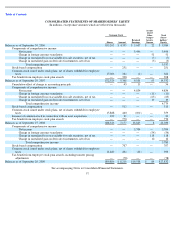Apple 2009 Annual Report Download - page 67
Download and view the complete annual report
Please find page 67 of the 2009 Apple annual report below. You can navigate through the pages in the report by either clicking on the pages listed below, or by using the keyword search tool below to find specific information within the annual report.
Table of Contents
Software Development Costs
Research and development costs are expensed as incurred. Development costs of computer software to be sold, leased, or otherwise marketed are
subject to capitalization beginning when a product’
s technological feasibility has been established and ending when a product is available for
general release to customers. In most instances, the Company’
s products are released soon after technological feasibility has been established.
Therefore, costs incurred subsequent to achievement of technological feasibility are usually not significant, and generally most software
development costs have been expensed.
In 2009 and 2008, the Company capitalized $71 million and $11 million, respectively, of costs associated with the development of Mac OS X
Version 10.6 Snow Leopard (“Mac OS X Snow Leopard”),
which was released during the fourth quarter of 2009. During 2007, the Company
capitalized $75 million of costs associated with the development of Mac OS X Version 10.5 Leopard (“Mac OS X Leopard”)
and iPhone
software. The capitalized costs are being amortized to cost of sales on a straight-
line basis over a three year estimated useful life of the
underlying technology.
Total amortization related to capitalized software development costs was $25 million, $27 million and $13 million in 2009, 2008 and 2007,
respectively.
Advertising Costs
Advertising costs are expensed as incurred. Advertising expense was $501 million, $486 million and $467 million for 2009, 2008 and 2007,
respectively.
Stock-Based Compensation
The Company accounts for stock-
based payment transactions in which the Company receives employee services in exchange for (a) equity
instruments of the enterprise or (b) liabilities that are based on the fair value of the enterprise’
s equity instruments or that may be settled by the
issuance of such equity instruments. Stock-based compensation cost for restricted stock units (“RSUs”)
is measured based on the closing fair
market value of the Company’s common stock on the date of grant. Stock-
based compensation cost for stock options is estimated at the grant
date based on each option’s fair-value as calculated by the Black-Scholes-Merton (“BSM”) option-
pricing model. The Company recognizes
stock-based compensation cost as expense ratably on a straight-
line basis over the requisite service period. The Company will recognize a benefit
from stock-
based compensation in equity if an incremental tax benefit is realized by following the ordering provisions of the tax law. In addition,
the Company accounts for the indirect effects of stock-
based compensation on the research tax credit, the foreign tax credit and the domestic
manufacturing deduction through the income statement. Further information regarding stock-
based compensation can be found in Note 7,
“Shareholders’ Equity and Stock-Based Compensation.”
Income Taxes
The provision for income taxes is computed using the asset and liability method, under which deferred tax assets and liabilities are recognized
for the expected future tax consequences of temporary differences between the financial reporting and tax bases of assets and liabilities, and for
operating losses and tax credit carryforwards. Deferred tax assets and liabilities are measured using the currently enacted tax rates that apply to
taxable income in effect for the years in which those tax assets are expected to be realized or settled. The Company records a valuation
allowance to reduce deferred tax assets to the amount that is believed more likely than not to be realized.
During 2008, the Company adopted FASB Accounting Standards Codification (“ASC”) 740, Income Taxes
(formerly referenced as FASB
Financial Interpretation No. 48, Accounting for Uncertainty in Income Taxes – an
64
























